The OCZ Trion 150 SSD Review
by Billy Tallis on April 1, 2016 8:00 AM ESTATTO
ATTO's Disk Benchmark is a quick and easy freeware tool to measure drive performance across various transfer sizes.
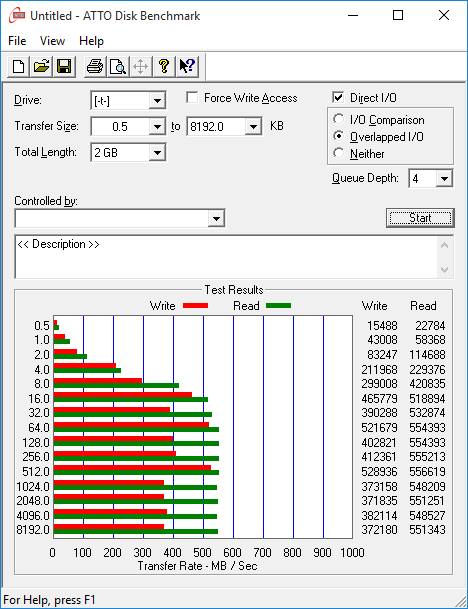 |
|||||||||
The 240GB Trion 150's write speeds are a bit uneven, but the larger capacities are perfectly normal with write speeds that are only slightly behind read speeds.
AS-SSD
AS-SSD is another quick and free benchmark tool. It uses incompressible data for all of its tests, making it an easy way to keep an eye on which drives are relying on transparent data compression. The short duration of the test makes it a decent indicator of peak drive performance.
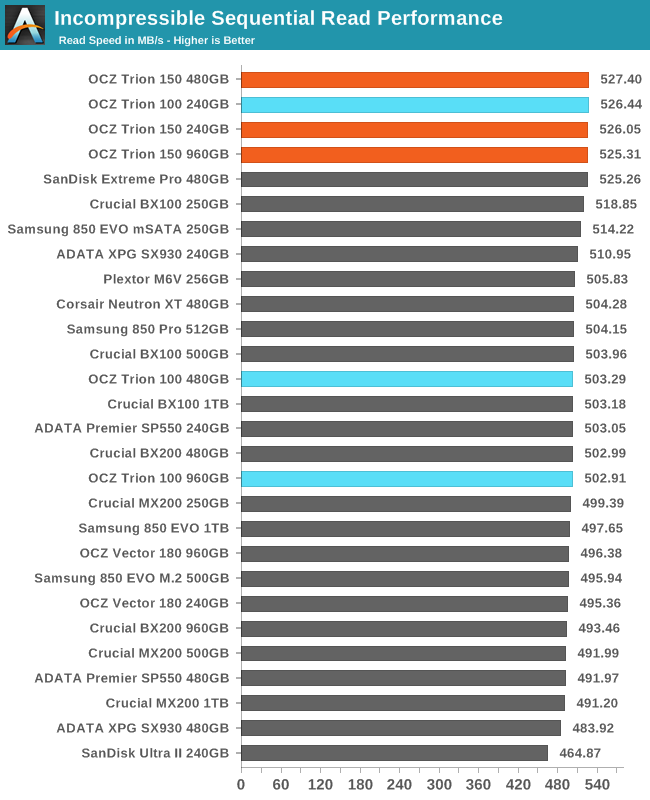
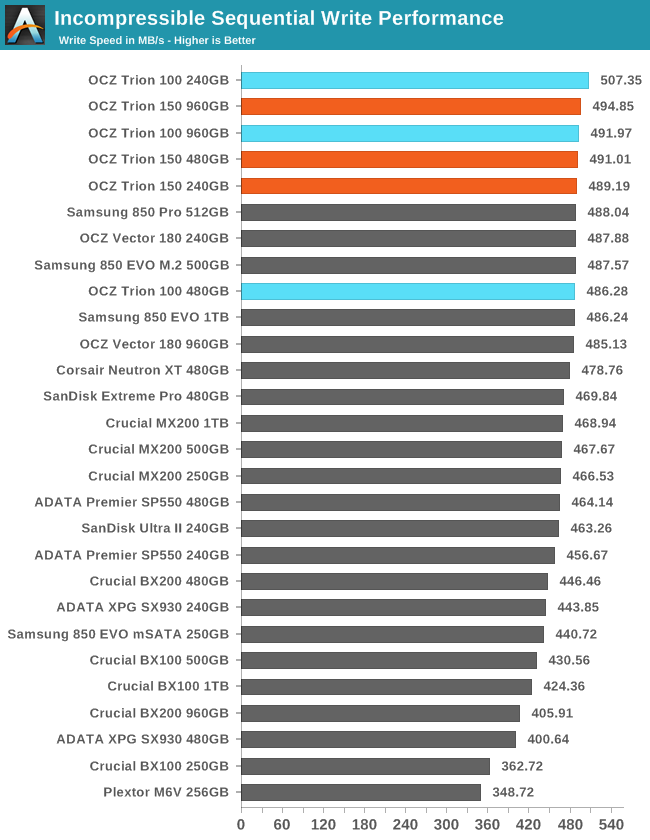
The Trion 150 manages to mostly top the (SATA) charts for peak read and write speeds, but the distinction is meaningless given how close the competition is.
Idle Power Consumption
Since the ATSB tests based on real-world usage cut idle times short to 25ms, their power consumption scores paint an inaccurate picture of the relative suitability of drives for mobile use. During real-world client use, a solid state drive will spend far more time idle than actively processing commands. Our testbed doesn't support the deepest DevSlp power saving mode that SATA drives can implement, but we can measure the power usage in the intermediate slumber state where both the host and device ends of the SATA link enter a low-power state and the drive is free to engage its internal power savings measures.
We also report the drive's idle power consumption while the SATA link is active and not in any power saving state. Drives are required to be able to wake from the slumber state in under 10 milliseconds, but that still leaves plenty of room for them to add latency to a burst of I/O. Because of this, many desktops default to either not using SATA Aggressive Link Power Management (ALPM) at all or to only enable it partially without making use of the device-initiated power management (DIPM) capability. Additionally, SATA Hot-Swap is incompatible with the use of DIPM, so our SSD testbed usually has DIPM turned off during performance testing.
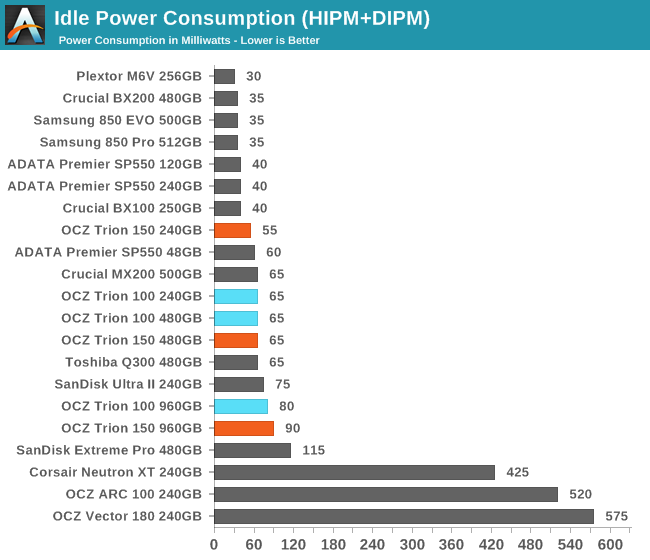
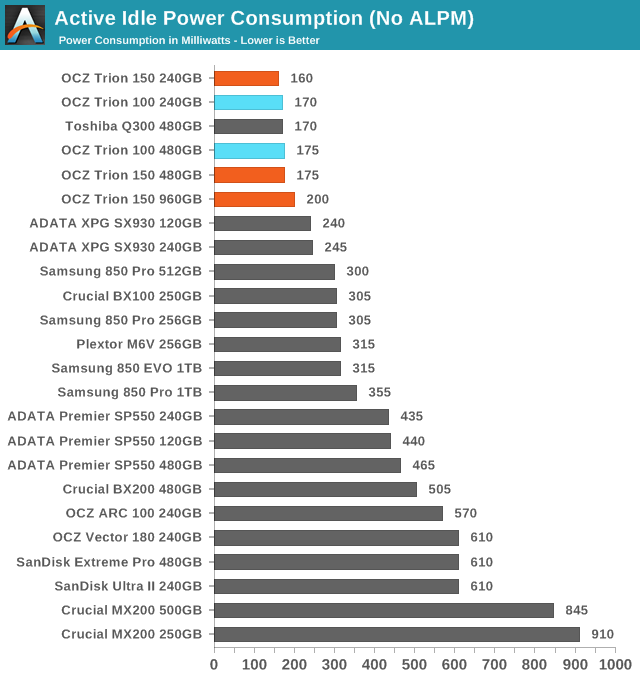
With and without DIPM, the Trion 150 has similar idle power consumption to its predecessors based on the TC58 controller. It's the best at saving power when ALPM is unavailable, and its device-initiated power management works properly.










79 Comments
View All Comments
RBFL - Saturday, April 2, 2016 - link
What do you define as decent priced?xrror - Saturday, April 2, 2016 - link
The worst part I'm guessing is finding anything decently priced that isn't 1366x768. I hate that resolution so much. My keep looking to replace my old core2 craptop that wheezes along (sadly it uses the most gimped/market segmented version of the Intel 945GM chipset), But it uses an old school 1440x900 screen - and that vertical space I refuse to give up.Sorry folks, when I see 768 - that was only cool back when 1024x768 was an upgrade from VGA's 800x600. F going back.
Samus - Sunday, April 3, 2016 - link
Look at HP Elitebooks like the 820 and 840, they come standard with 1600x900 screens (which is a perfect resolution on the 12.5" 820.1920x1080 is fine and all on a 14"+ but really sucks on a 11-13" unless you have display scaling. Windows 7 and Linux it just sucks unless you have eagle vision.
BurntMyBacon - Monday, April 4, 2016 - link
@Samus: "Look at HP Elitebooks like the 820 and 840, they come standard with 1600x900 screens (which is a perfect resolution on the 12.5" 820."I do rather like that resolution for this size on a notebook. Tablets are generally used at a closer distance, but I digress.
@Samus: "1920x1080 is fine and all on a 14"+ but really sucks on a 11-13" unless you have display scaling. Windows 7 and Linux it just sucks unless you have eagle vision."
Yet I'd still rather see 1920x1080 than 1366x768 as I find it less frustrating to lean a little closer when I need to than to not be able to get the content I want on screen. Until better scaling is commonplace, 1680x1050 or 1600x900 please.
Arbie - Friday, April 1, 2016 - link
The link below is a 2011 review on Anandtech, showing Velociraptor scores vs SSDs of the time. You can estimate pretty well from that how things would compare now.FYI, the Mushkin Reactor 1TB MLC SSD (reviewed here recently) is available for $220 on NeweggBusiness.
http://www.anandtech.com/show/4337/z68-ssd-caching...
Samus - Sunday, April 3, 2016 - link
Excellent drive (the Mushkin Reactor) I have recommended it at least a dozen times and never heard a complaint. Stark contrast to the one person who didn't take my advice (I have two of them so I know how good they are) and bought the Sandisk Ultra II 960GB instead because it was $20 cheaper. It failed on them after 4 months. Which is alarmingly common if you read the reviews on Newegg.Ryan Smith - Friday, April 1, 2016 - link
"Second, would it be at all reasonable to add a WD VelociRaptor, Hybrid SSHD, and/or common 5400RPM hard drive to the 2015 SSD Bench like the old days?"It's definitely something we can look into. Keep in mind that we'd only be able to use them for a portion of the tests though; even a 7200 RPM drive would be impossibly slow on tests like the Destroyer that involve a lot of random activity.
BurntMyBacon - Monday, April 4, 2016 - link
@Ryan Smith: "It's definitely something we can look into. Keep in mind that we'd only be able to use them for a portion of the tests though; even a 7200 RPM drive would be impossibly slow on tests like the Destroyer that involve a lot of random activity."That is fine. The destroyer was made to tease out differences in performance and consistency between SSDs that are so high end that are hidden in lesser tests. One of your other (far less strenuous) tests is good enough as a reference point to show how HDDs stack with respect to random activity.
jsntech - Friday, April 1, 2016 - link
From a strictly business point of view, Toshiba should probably re-brand OCZ to some other name. Not a single member of my moderate circle of pro or power user friends will ever touch anything with OCZ in the name again. And they all told their friends, and they all told their friends, etc.Flunk - Friday, April 1, 2016 - link
I'd personally be happier with "Toshiba".